Inside NYC’s Brick-and-Mortar Shopping Revival
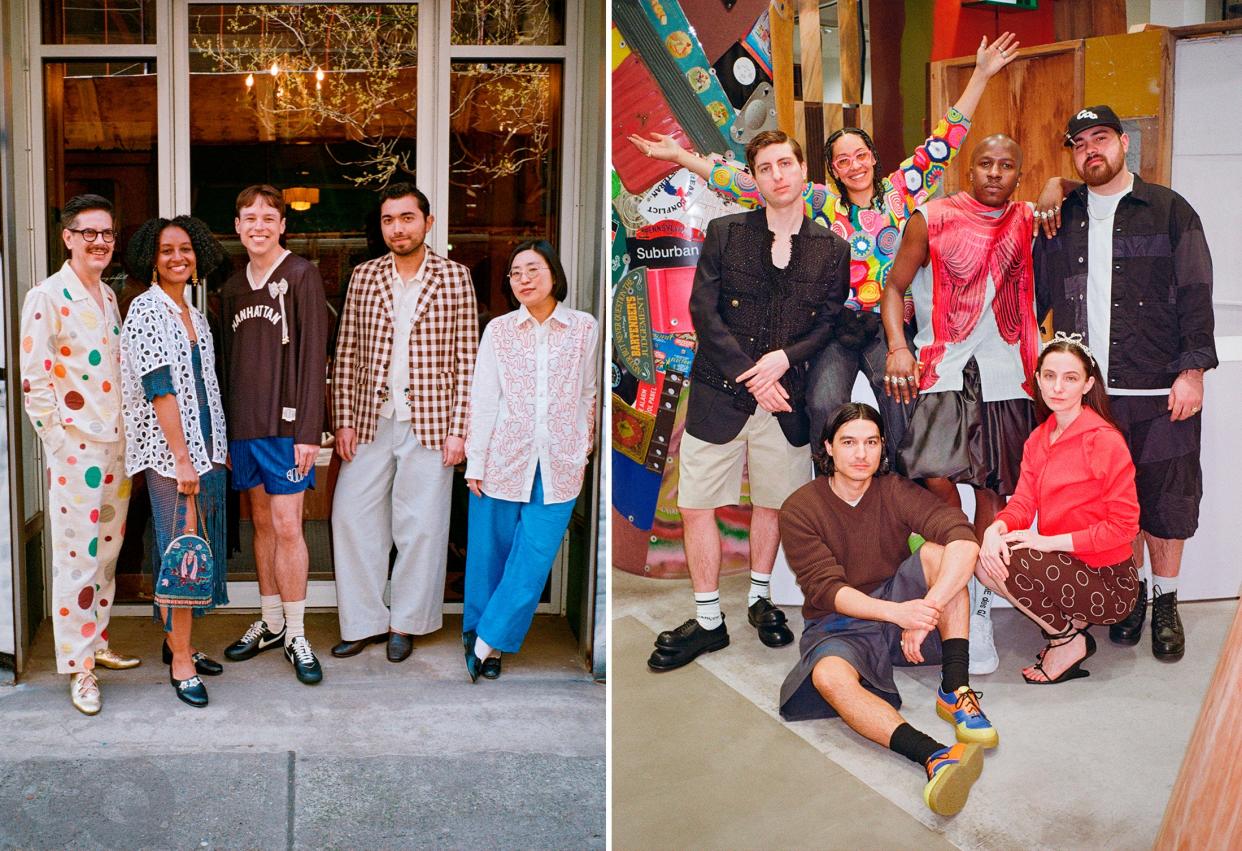
There was some talk of late, albeit in hushed tones, that New York isn’t a great city to shop in—or at least isn’t as great as it used to be. That the city’s great shopping institutions like Barneys, Jeffrey, Opening Ceremony, and Totokaelo have been bulldozed in favor of chopped salad bars, bank chains, and jumbo-size drug stores. That the pandemic somehow sucked the wind out of the sails of a robust and lively retail scene, and that no boutique can compete with the reigning e-comm titans. But spend an afternoon shopping in New York this summer and you’ll discover why this notion is flat-out wrong.
Now, is shopping in New York different today from what it once was, even just two or three years ago? Yes, absolutely. How could it not be? The city is in a constant state of reinvention, like a snake shedding its skin, and the way it shops is in a constant state of flux. Shopping in New York today is less about worshipping at the few great temples of retail, and more like visiting an archipelago of many small islands scattered across the city, each with its own particular language, customs, rhythms, and quirks. Indeed, its own culture. Walk through its front door and you’ll be transported into a distinct world.
I thought of this recently as I stopped off at the earth-toned sliver of a shop, Colbo, to speak with Eldar Hadad; my mission was to discuss the store, which she runs with her business partner Tal Silberstein, but it was hard to pin her down as she worked the sales floor and greeted customers who were, as often as not, friends.
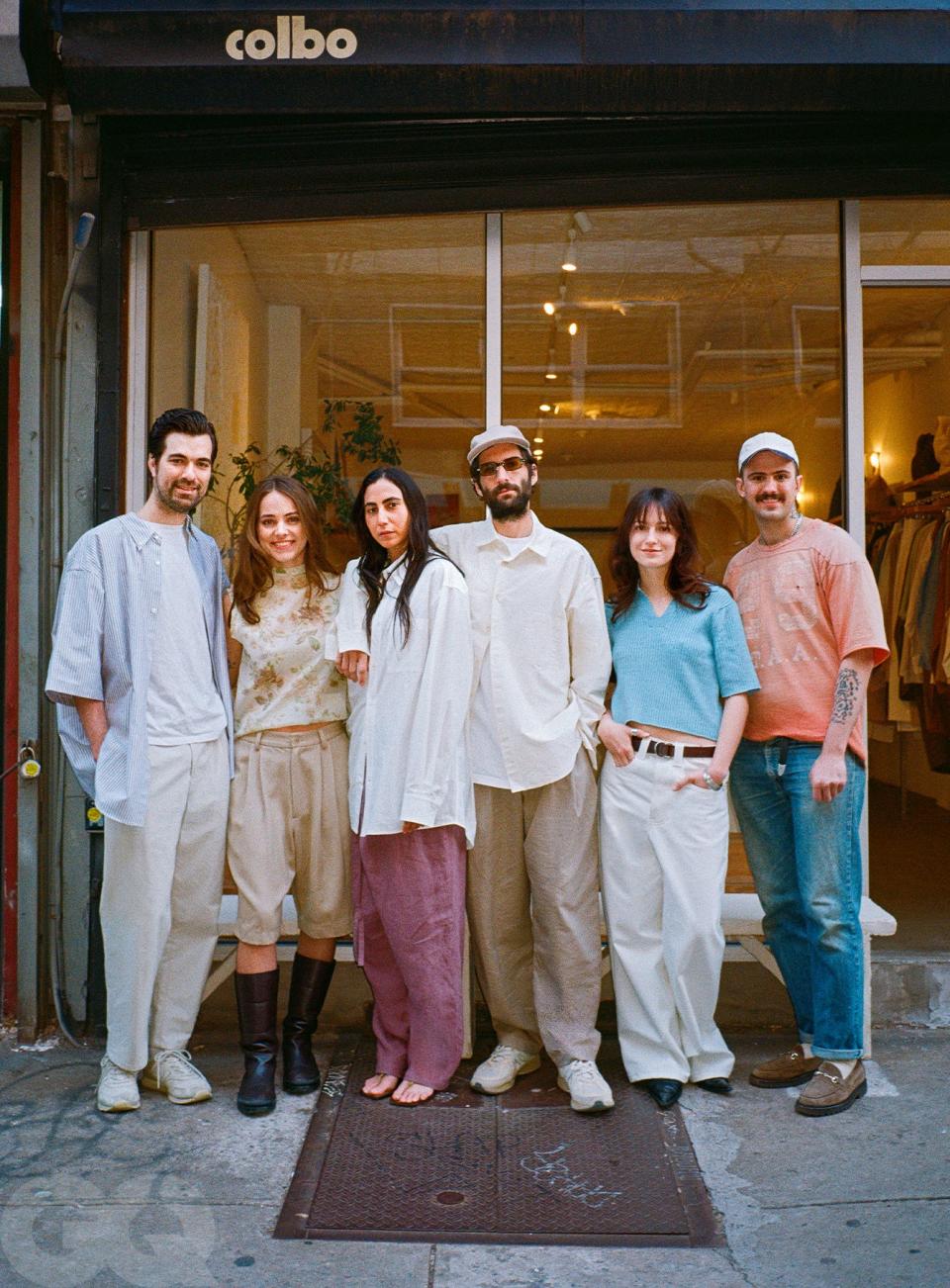
NEIGHBORHOOD: Lower East Side
Founded: 2021
Owned by: Tal Silberstein, Eldar Hadad, Ryan Dougherty, Daniel Reitten
Brands: Hed Mayner, Camiel Fortgens, Yoko Sakamoto, Sillage, Kartik Research, Porter Yoshida, Cawley, plus a wide selection of ’90s-ish vintage
Vibe: Laid-back Middle Eastern coffee shop
Hadad, Silberstein, and their two other cofounders flung open their doors on a bustling stretch of Orchard Street in the Lower East Side in 2021, and it was, almost instantly, a hit. What they sell is by no means revolutionary: The pair offer up a smattering of culty menswear brands—Adish, Kartik Research, Hed Mayner, Satta among them—plus a rack or two of discerningly chosen vintage items, with an emphasis on ’90s finds from Dries Van Noten, DKNY, and Armani. But the Colbo experience is way more lively and dynamic than what you’d expect from a typical multi-brand boutique.
“It’s hard for me to call it a store,” said Silberstein, who has wanted his own shop since he was a child. “For me it’s so much more than that, it’s my vision of life, it’s a creative expression of myself.”
The day I dropped in, the space was thrumming: guys huddled, holding roomy trousers or embroidered shirt jackets, outside the two dressing rooms while others queued up for coffee or iced chai doled out by a tattooed barista. A DJ was spinning music in the front, where plain white benches and wood-block stools were crammed with chattering customers. Outside, a chef from Japan was serving warm chicken curry and dal at a makeshift stove top, part of a party for a collaborative capsule collection the store was launching with the brand Ernie Palo, from Tokyo. On the sidewalk in front of the store, a bottleneck of pedestrians was swelling from the skateboard competition that had shut down the adjacent block. The crowds gravitated toward Colbo to see what the fuss was about, lured by the sound of music and the smell of food. The whole thing had an incredibly cozy, neighborhoody vibe—you were destined to see a friend, or make one. Hadad, wearing all black and with a tangle of thick dark hair, was running back and forth in the shop, stopping to greet friends with a winking, if frazzled, smile or discreetly tucking behind the checkout to enter a discount.
At Colbo—which comes from a Hebrew word that means “a store with everything in it”—events are critical to what Hadad and Silberstein are building. They were a foundational piece of what the two imagined a shop could offer in New York City right now.
“We wanted rotating events, exhibits, pop-ups, stuff like that. To work with people and get their communities involved and turn them into our community,” Silberstein said. “To sit at the intersection of fashion, art, music, hanging out, coffee, all those things I’ve done in my life.”
“There’s these moments,” he continued, “that I’ll walk into the shop and there will be 10 people shopping; someone’s buying something, someone’s drinking a coffee, the music is nice.… I’m like, I’ve been dreaming of this since I was a kid.”
There is no better way to feel part of New York’s essence, its ineffable electric charge, than to set out on foot and go shopping. It was a mild spring day, and the stores were freshly stocked with new arrivals, and display windows were filled with signs of the coming summer season, like relaxed pleated shorts, linen shirts, fisherman sandals, and bucket hats. To go shopping on a warm, cloudless day in New York—not for something in particular, necessarily, but to let the very act of searching be your objective—is to partake in one of the city’s great pleasures. It’s a reminder to stay curious and receptive. That shopping isn’t so much about acquiring objects as it is about connecting with people. The humbling experience of a person showing you something they think is cool, and hoping you might feel the same. Shopping is, at its core, a conversation, an act of communion. And in New York, you’re communing with the coolest, smartest, and freakiest people in the world.
Nowhere is this thrilling reminder of what shopping can be more evident than in the recent crop of small-to-midsize boutiques that reflect a shaggier, folksier, and funkier snapshot of post-pandemic life, of a city still enamored with moving forward, dedicated to discovery, obsessed with the new.
Isaac Hindin-Miller, a DJ and content creator who has a popular “Best of...” interview series on his @isaaclikes_ Instagram page asking tapped-in urbanites their favorite neighborhood haunts, has seen a notable shift of late. “A lot of stores have opened over the last 12 months, and way more young people are starting brands and taking a crack at the retail game, which is exciting to me,” he said. “It feels like the energy of my youth when people were way more willing to just try it out.” His favorite area to peruse, as it happens, is Orchard Street—from new multi--brand shops like Colbo to flagships for smaller brands like Sandy Liang and Awake to carefully curated resale from Desert Vintage, it’s all there. “I see a real community being built around my favorite stores,” he added. “They’re places where people want to go and hang out rather than just shop.… The clash between seen-it-all natives and rose-lensed transplants and billionaires and rats creates an incredible tension.”
Or, as the journalist and critic Jon Caramanica put it: “It’s important to remember that even on its worst day, New York is the best American city for shopping.” Caramanica should know—he covered shopping for The New York Times, helping to write its Critical Shopper column. “It will always be the bellwether of interesting stuff, the first mover. Those big multi-brand stores, that were like a one-stop shop, now I think you have to try a little harder. It’s not being served up to you on a platter. But I also think that the general IQ of a person who’s interested in good menswear is higher now.”
He pointed to the store Antithesis, in Nolita. “A store like that would not have existed in New York five or ten years ago, but now you have just enough people who are interested in Japanese stuff like Acronym or unusual European streetwear that isn’t carried anywhere else.” In other words, the menswear scene has atomized, so how could the retail scene not adjust accordingly? “You lost two or three big umbrella places, but what has popped up is 10 or 15 different, diverse approaches to high-end shopping.”
Still, with the boom of boutiques in downtown Manhattan, plus the exploding vintage market and the inventive ways people are shopping in the city—from itinerant racks of carefully selected secondhand goods on street corners to closet sales from celebrities (Chloë Sevigny has hosted one) to underground menswear types (the guys from the men’s fashion podcast Throwing Fits hosted one), shopping in New York, according to Caramanica, still offers up plenty of thrills.
One Saturday afternoon not so long ago, I found myself at Dover Street Market, the seven--story store that has become the de facto godfather of New York’s retail scene by offering everything from sleek runway labels to streetwear standbys to the most emerging oddball newcomers. It’s a place that, despite being a multinational department store owned by Comme des Garçons, has retained a distinct and powerful sense of community. “There’s often a value placed on thinking logically, but we’re always thinking emotionally,” Drew Romero, the store’s menswear buyer, told me one Saturday afternoon as we stalked the floors, oohing and aahing like dweebs at the latest Undercover arrivals; discussed how good Stüssy was right now; and bemoaned the recent news that Dries Van Noten was retiring. “The emphasis on emotion, on creativity, on energy, is what keeps us moving forward,” Romero, in a threadbare cropped vintage tee and slouchy Margiela jeans, said. “It’s not about the quick sale or selling out of a sneaker; sometimes we bring something in because it’s an amazing item.”
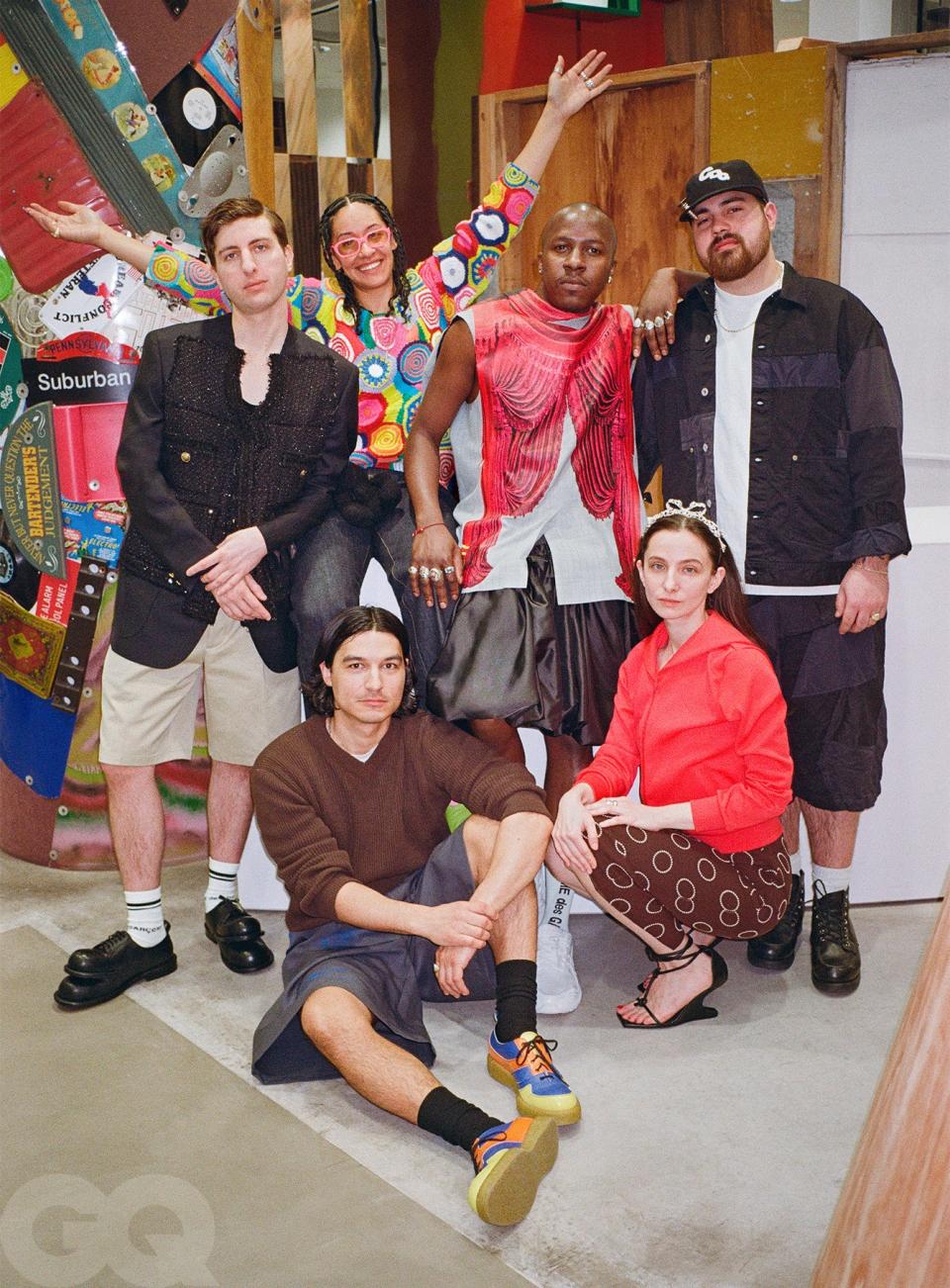
NEIGHBORHOOD: Murray Hill
Founded: 2013 (the original, in London, opened in 2004)
Owned by: Comme des Garçons
Brands: All Comme des Garçons labels, Junya Watanabe, Prada, Miu Miu, Rick Owens, Margiela, Supreme, Stüssy, Evan Kinori, Craig Green, Sacai, Willy Chavarria, Our Legacy, Lemaire, and more
Vibe: An arts and crafts store on psychedelics
Invoking the word emotion when it comes to sneakers and sweaters might make one grimace, but spend a few hours at DSM and you get his point. How else do you explain the strange rush you get from seeing a CdG Homme Plus jacket that resembles a pair of drawn curtains (putting your torso at center stage) or a Prada canvas barn coat (women’s, not that it matters) so perfect that had Hamilton Carhartt seen it, he’d have packed up and called it a day? (“It just blew minds,” Romero marveled.) Each craggy corner and tucked-away rack is filled with Easter eggs like this. Vintage Cartiers and Rolexes in a glass case on the ground level, wonderfully fitting Supreme chinos on the top floor, the swaggering drama of oversized Willy Chavarria Dickies-style shirts and trousers tucked away in the basement. It’s a wonder how the shop doesn’t buckle under the weight of its own ambition. Still, it’s a stimuli overload of the finest degree—at turns dizzying, confounding, and energizing—an inspirational pilgrimage worthy of an afternoon, if not a full day (take a seat at Rose Bakery for provisions should you find your blood sugar lagging).
Now contrast that with La Garçonne, on a cobblestone street in Tribeca. Compared to DSM’s unruly sprawl, La Garçonne is a laser-focused selection presented simply and thoughtfully. The store, founded by Kris Kim as an e-commerce venture way back in 2005, opened a physical storefront a decade ago and just relaunched menswear two years ago after a long sabbatical. The space conjures a classic downtown loft plus a touch of dreamy zen, with white-painted brick walls, sun streaming in through industrial skylights at photo-friendly angles, and oversized Noguchi lamps hovering overhead. The curation, meanwhile, emphasizes labels that are rooted in a certain romance and pragmatism: The Row, Lemaire, Auralee, and Margaret Howell are the standouts, and Yohji Yamamoto was added this spring.
“New York is the best place to do this,” Kim told me. “It’s tough, but if you’re focused, you know who you’re catering to, and you work hard, this is the place to do it, because people will appreciate it. The interest level in this type of design is high here.”
Reuben Perin, the store’s menswear buyer, noted that a shop like this could only exist here because the neighborhood has such a discerning crowd. Clients don’t want just stuff, they want the very best stuff, stuff that’s considered and that has a story behind it. Here you’ll find a knowledgeable shopper but one that wants to be surprised, not merely catered to. Perin also shyly said that New York offers something unique and necessary for a shop like La Garçonne: customers with ample money and good taste.
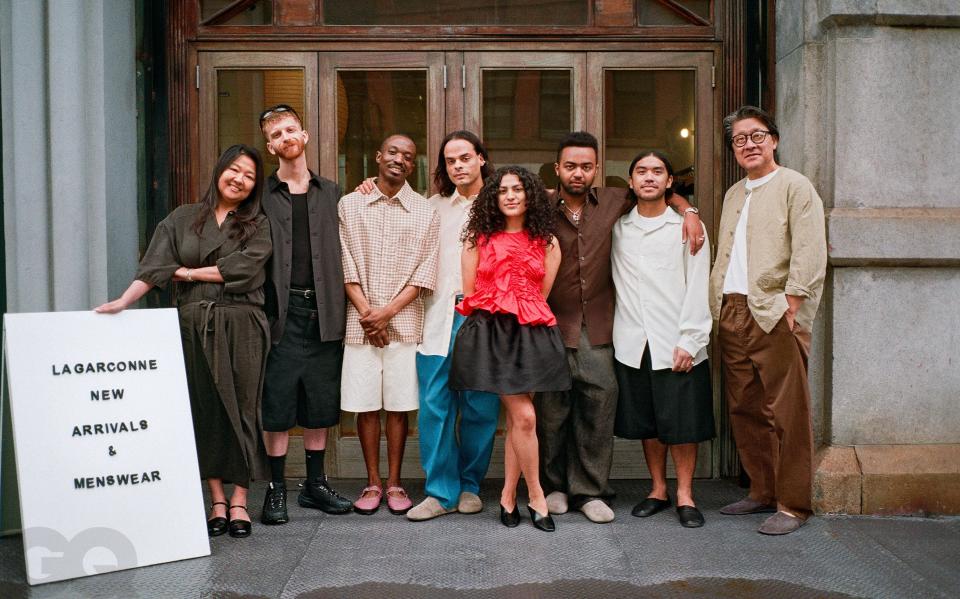
NEIGHBORHOOD: Tribeca
Founded: 2005 online, physical shop in 2014
Owned by: Kris Kim
Brands: Dries Van Noten, Lemaire, Casey Casey, Margaret Howell, The Row, Auralee, Yohji Yamamoto
Vibe: Evocative urbane minimalism
“I mean, we get guys who will come in and know exactly what they want, and will be like, Oh, I love Camiel Fortgens, and they’ll know what he made this season,” he said, picking up slim leather slippers from The Row (a bestseller at just under a grand) and then admiring a pair of roomy shorts he’s been eyeing from Sacai with a backside that looks like a pleated skirt. “Guys are nerdy like that, in the best way. They’re investigators. But we also get guys who just appreciate nice things but need information and need a more handheld approach, which I love.”
Or take Nepenthes, just two-and-a-half miles due north but, aesthetically speaking, a world away. Located on a grubby block in the Garment District, just off Times Square, it’s the storefront of the company that oversees the beloved brands Engineered Garments, Needles, and South2 West8, all of which engage in the spirited conversation happening between American and Japanese fashion. The Engineered Garments design offices were once housed upstairs, and the place retains its workshop vibes: white walls, industrial overhead lighting, and racks and racks of merchandise. Indeed, the shop supplies a very deep offering from each of these labels, while upstairs is reserved mostly for collaborations (which recently included an upcycled sailcloth parka and a tote bag made with Western Hydrodynamic Research and Mafia Bags) and one of the best shoe selections in the city.
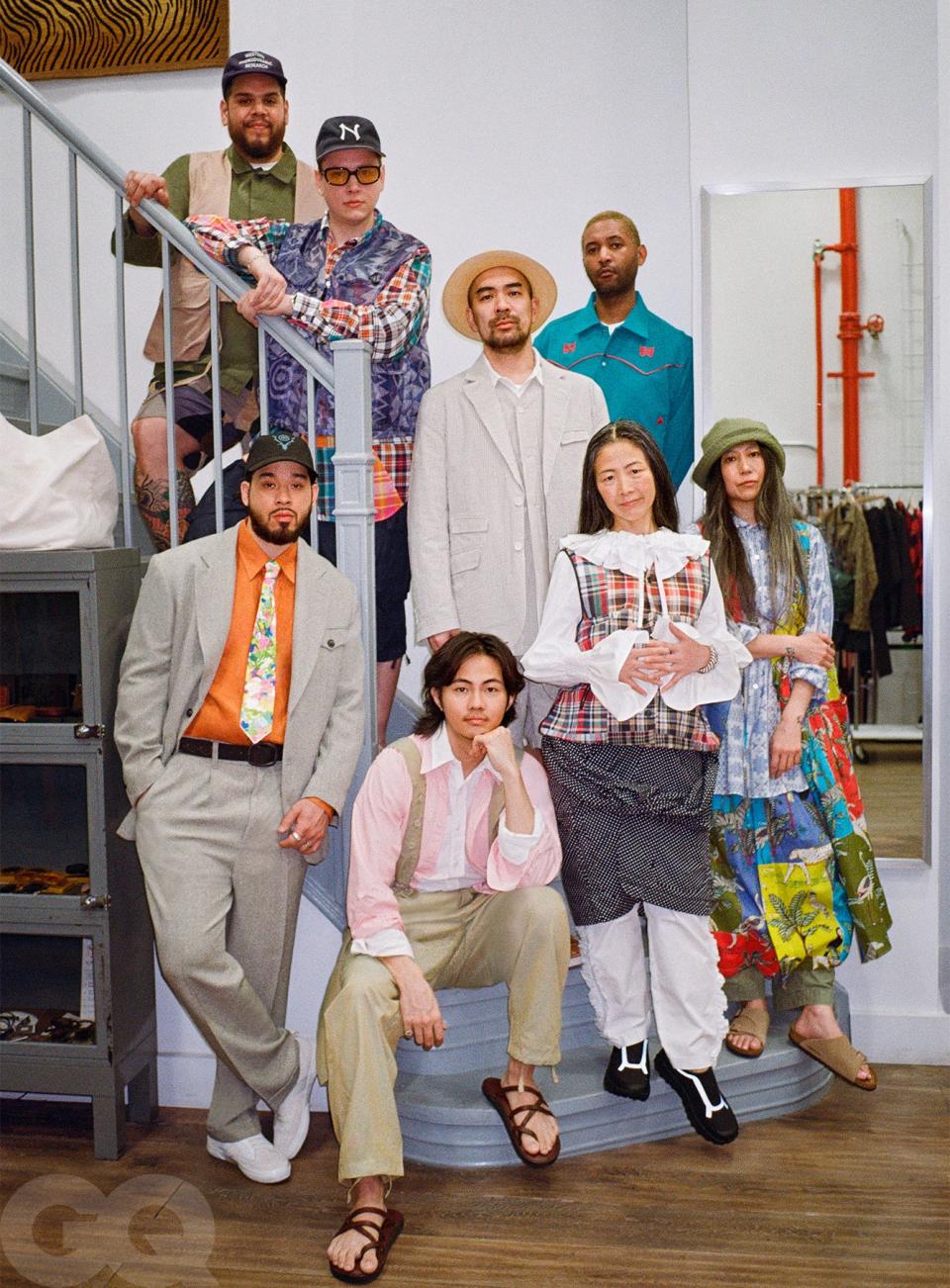
NEIGHBORHOOD: Garment District
Founded: 2010
Owned by: Daiki Suzuki
Brands: Needles, Engineered Garments, South2 West8, plus shoes from New Balance, Hoka, Alden, Trickers, and more
Vibe: Industrial showroom with a whiff of the American Southwest by way of Japan
It’s there where I chatted with James Donovan, who quit his job in corporate finance to take on Nepenthes’s press communications and, in his spare time, work the sales floor. He told me how the store, due to its location, mostly attracts destination shoppers, or those very familiar with the brands, and not as many casual passersby, were it located in, say, SoHo. Indeed, the day I went, the clientele seemed to be dressed, sometimes to a T, by one of the brands, and more than a few spoke in foreign languages. Several visitors checked their phones on the sidewalk before entering, as if making sure they’d found the magical X that marks the spot they’d long been searching for. In some cases, maybe they had.
These fans come to Nepenthes not just to shop but to talk shop. The clothes here are replete with idiosyncratic construction details and made from obsessively sourced textiles, and it’s the type of clothing that builds something akin to its own subculture. Consider this its clubhouse. Donovan noted that guys can be obsessive, and he’s spent great lengths of time talking with customers about the reason the hem of a shirt was left unfinished or how, exactly, a wobbly seam was constructed, or how to style a baggy pair of cargo pants.
The city is teeming with purveyors like these, from the functional and elegant camping gear at Hatchet Outdoor Supply Co. in Brooklyn Heights to the minimalist sportswear and relaxed tailoring at the subterranean menswear haven C’H’C’M in NoHo, each shop with its own unique personality and worldview. More important, these are places run by real people, who have a passion for clothing, for how things look and how they feel on the body. As a fellow clothes person, you enter knowing that you’ve found your tribe. They care about things like craftsmanship and storytelling, obsess over how a certain type of cotton absorbs indigo dye, say, or the way an extra inch of trouser rise can yield a pair that might, just might, change the trajectory of your life. Not only that, they’ll talk to you about clothes, go deep on the details, match your enthusiasm. They’re people who enjoy connoisseurship, learning and then sharing what they’ve found.
It reminds me of the way that at Bode, a dark-wood-paneled jewel box just a stone’s throw from the lively scene at Colbo, the salespeople jump at the chance to talk about founder Emily Adams Bode Aujla’s vision. When I mentioned that I loved the lacy edging at the hem and yoke of a boxy shirt, the young mustachioed staff person told me it was actually based on an antique tablecloth. Bode Aujla’s whole thing is working with older textiles, re-creating things from history, and, in the act, imbuing her clothes with a certain reverence for the past—not nostalgia, per se, but a wistful remembrance. But casual browsers don’t need to know all that to appreciate the latest spring arrivals in the shop, like that boxy shirt made from old tablecloths. I liked how it fit—a little wide and slightly cropped so it hit me right at the waist. I liked that the lace showed just a little bit of unexpected skin; it would be airy in the warmer months and—dare I say it?—a little sexy. I liked the idea that it evoked a sense of domesticity. I also liked thinking about Bode Aujla coming across a tablecloth somewhere in her travels, maybe at an estate sale in Alabama or a flea market in Kentucky, and getting excited, suddenly a creative spark ignited.
And when I left the store with that shirt tucked into its bag and stepped out into the waning afternoon light, the sounds and smells of the city surrounding me, I felt that same spark too.
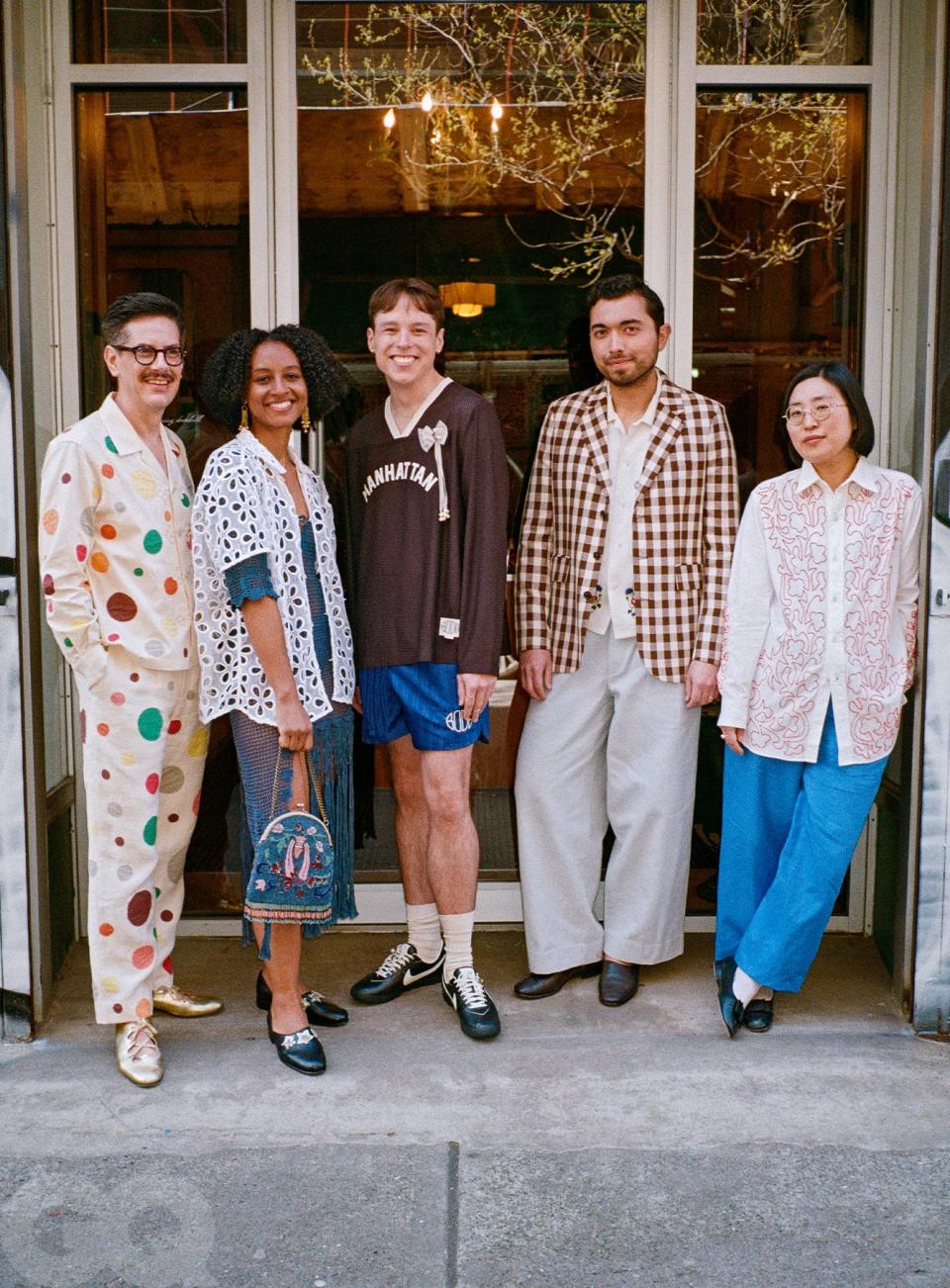
Max Berlinger is a freelance writer based in Brooklyn.
A version of this story originally appeared in the Summer 2024 issue of GQ with the title “New York’s Great Brick-and-Mortar Shopping Revival”

FASHION CREDITS:
Bode: FROM LEFT: On Kevin Maloney: Jacket, pants, and shoes by Bode. On Kivvi Roberts: All clothing and accessories by Bode. On Dalton Young: Shirt, shorts, and sneakers by Bode Rec. and Nike. Socks by Bode. On Luis Diaz: All clothing and shoes by Bode. On Sang Kim: All clothing and shoes by Bode. All other clothing and accessories, subjects’ own.
Colbo: FROM LEFT: On Ryan Dougherty: Shirt by Hed Mayner. Pants by Colbo. On Mia Rothrock: Shirt and shorts by Colbo. On Eldar Hadad: Shirt and pants by Colbo. On Tal Silberstein: Shirt, pants, and hat by Colbo. Sunglasses by Tejesta. On Angelique des Francs: Shirt by Ernie Palo. Pants by Colbo. Belt by Yoko Sakamoto. On Brandon Dent: T-shirt by Southern Manufacturing. Jeans by Levi’s Vintage. Hat by Camiel Fortgens. All other clothing and accessories, subjects’ own.
Dover Street Market New York: FROM LEFT: On Jake Levy: Jacket by Junya Watanabe Man. Tank top by Lemaire. Shorts by Prada. Shoes by Comme des Garçons Homme Plus x Kids Love Gaite. Socks by Comme des Garçons. On Drew Romero: Sweater by The Row. Shorts by Comme des Garçons. Subject’s own shoes by Comme des Garçons Homme Plus. On Angelica Rosario: Shirt by Comme des Garçons. Jeans by Junya Watanabe Man. On Rashaad Anderson: Jacket by Comme des Garçons Homme Plus. Shorts by Noir Kei Ninomiya. Sneakers by Comme des Garçons Shirt x Asics. Socks by Comme des Garçons. On Margeaux Cohen: Hoodie by Comme des Garçons Girl. Skirt by Prada. Shoes by Rick Owens. Headband by Shushu/tong. On Michael Moran: Shirt and shoes by Comme des Garçons Homme. Hat accessory by Malcolm Ransome. All other clothing and accessories, subjects’ own.
La Garçonne: FROM LEFT: On Kris Kim: Dress and shoes by Lemaire. On Vinny Simeone: Shirt by The Row. Shorts by Comme des Garçons Homme Plus. Sneakers by Nike ACG. On Washaou Davis: Shirt and shorts by Camiel Fortgens. Shoes by Magliano. On John Nunez: Shirt by Auralee. Jeans by Camiel Fortgens. Shoes by The Row. On Dominic Jimenez: Shirt by Cecile Bahnsen. Skirt by Ter et Bantine. Shoes by Le Monde Beryl. On Noah Condiff: Shirt by Stein. Pants by
Yohji Yamamoto Pour Homme. Shoes by The Row. On Reuben Perrin: Shirt and shoes by The Row. Shorts by Comme des Garçons Homme Plus. On Da Kim: Shirt by Casey Casey. T-shirt by Dries Van Noten. Pants by Lemaire. Shoes by The Row. All other clothing and accessories, subjects’ own.
Nepenthes New York: CLOCKWISE FROM TOP LEFT: On Leo Zepeda: Vest, jacket, and shorts by Engineered Garments. Hat by NNY x Western Hydrodynamic Research. On James Donovan: Vest by South2 West8. Shirt and shorts by Engineered Garments. On Takuya Yamamoto: Jacket, vest, and shorts by Engineered Garments. Shirt by Needles. Hat by Ecua-Andino. On Winston Tolliver: Jacket by Needles. T-shirt by Engineered Garments. On Miki Sakurada: Dress, shirt, and skirt by Engineered Garments x FWK. Pants by Needles. Shoes by Birkenstock. Hat by Engineered Garments. On Eri Shoji: Jacket (at waist) and vest by Engineered Garments. Shirt and pants by Rhodolirion. Shoes by Norda. On Yodai: All clothing by Engineered Garments. Shoes by The Piper Sandal Company. On Teddy Pichardo: Jacket, shirt, pants, and belt by Needles. Sneakers by Engineered Garments x Superga. Tie by Engineered Garments. Hat by South2 West8. All other clothing and accessories, subjects’ own.
PRODUCTION CREDITS:
Photographs by Marie Tomanova
Bode: Hair by Francis Rodriguez at The Wall Group; Makeup by Christian Briceno at The Wall Group.
Nepenthes: Hair by Ayumi Yamamoto using Kérastase; Makeup by Magdalena Major using Augustinus Bader.
La Garconne and Dover Street Market: Hair by Ayumi Yamamoto using Kérastase; Makeup by Ai Yokomizo using Fenty.
Colbo: Hair by Francis Rodriguez at The Wall Group; Makeup by Christian Briceno at The Wall Group.
Originally Appeared on GQ


